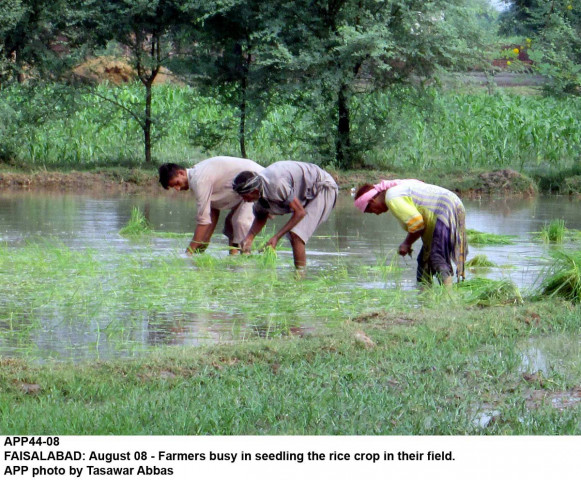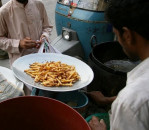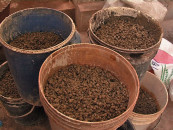Rice crop in danger due to water shortage
Many farmers have not sown the crop, though planting is normally completed by July

PHOTO: APP/FILE
They have been waiting for water to sow rice in the thousands of acres of paddy fields in Larkana, Dadu, Khairpur, Kamber-Shahdadkot, Kashmore and Jacobabad districts. The crop requires an extensive amount of water and without abundant supply of water, its cultivation cannot be started.
The paddy farmers have been protesting against the shortage of water, however, their hue and cry is apparently not affecting the authorities. The protesting farmers have staged sit-ins and observed hunger strikes in the last few weeks but the ongoing political wrangling due to the elections has become so all-encompassing that the authorities concerned have turned a blind eye to the issue.
According to the paddy farmers, the acute water shortage is not only feared to hit the rice crop but it has also translated into water disputes among different communities.
"Paddy sowing has been delayed. Normally, we get the water in mid-May and finish the sowing by July. More than 70% people have not sown their crop," said Mohammad Mosa, a farmer who lives near Kamber taluka.
Inflicting losses: Farmers urged to overcome pest attacks
Mosa and dozens of other farmers blocked the National Highway on Friday to divert the authorities' attention towards their plight but they were dispersed by the police with teargas. "We are now planning to observe hunger strikes in Larkana city," he said.
Ameer Ali Mugheri, the chairman of a union council, Lalu Raunk, in Kamber-Shahdadkot told The Express Tribune that many people who sowed the paddy sapling had not lost hopes of harvesting the crop.
"We spend all night monitoring the water, but all canals are dried up. Not a single drop can be found here. Irrigation officials are saying there is no water in the Indus River. They are telling us to wait for rains," Mugheri said
"I personally have sown paddy in around 200 acres, but all saplings have been gasping," he said decrying that he had lost the hope that he could harvest the crop this year.
In Larkana division, the Rice Canal is a major source of water for crops but it is completely dry at present. People from Naudero and Rato Dero from where Pakistan Peoples Party Chairperson Bilawal Bhutto Zardari has recently won the elections protested in Larkana city.
"This is the peak season and every year we would see abundant water in the Rice Canal, which is now shriveled," explained Jamal Daudpota, a local journalist. He added that peasants and farmers were staging protests every day but they were not being reported in the media as the media was only focusing on the post-elections political scenario.
‘Data of 8.7m farmers has been computerised’
The water shortage has also reportedly hit the paddy crop in lower Sindh were it is cultivated in Thatta, Badin, Mirpurkhas and Sanghar districts.
Speaking to The Express Tribune, Sindh Abadgar Board's Abdul Majeed Nizamani said around 2.2 million acres of paddy crop was yearly harvested in upper and lower Sindh, however, a major part of the crop would be affected this year due to water scarcity.
Nizamani added that Sukkur and Kotri barrages were major sources of irrigation in the province from where various canals, including Phuleli, Old Phuleli, KB Feeder, Rice and Dadu canals, would carry water to different districts of Sindh. "The water situation in all the canals is alarming because of shortage of water in the Indus," he said.
"We have approached the irrigation secretary and the [relevant] minister but all in vain," Nizamani lamented, adding that loss of paddy crop would be an economic blow for the province this year.
Criticising the government policies, he said growers and famers were vulnerable because they did not get any relief from elected governments. "In India, the price of urea fertiliser stands at six dollars per bag, but here we have to pay 15 to 16 dollars," he claimed, adding that despite the fact Pakistan was an agrarian country, all successive governments had ignored the agricultural economy.



















COMMENTS
Comments are moderated and generally will be posted if they are on-topic and not abusive.
For more information, please see our Comments FAQ